
News

News
On May 8th, the research group led by Professor Qian Xiaoshi from the Interdisciplinary Research Center of the School of Mechanical Engineering at Shanghai Jiao Tong University published a paper titled "Self-oscillating polymeric refrigerator with high energy efficiency" in the journal Nature. The co-first authors of the paper are Ph.D. candidate Han Donglin and Master's student Zhang Yingjing, with Professor Qian Xiaoshi as the corresponding author. Over the past six years since joining Shanghai Jiao Tong University, Professor Qian Xiaoshi has been involved in research that has resulted in the publication of six papers in the journals Nature and Science, four of which he has authored as the first or corresponding author.
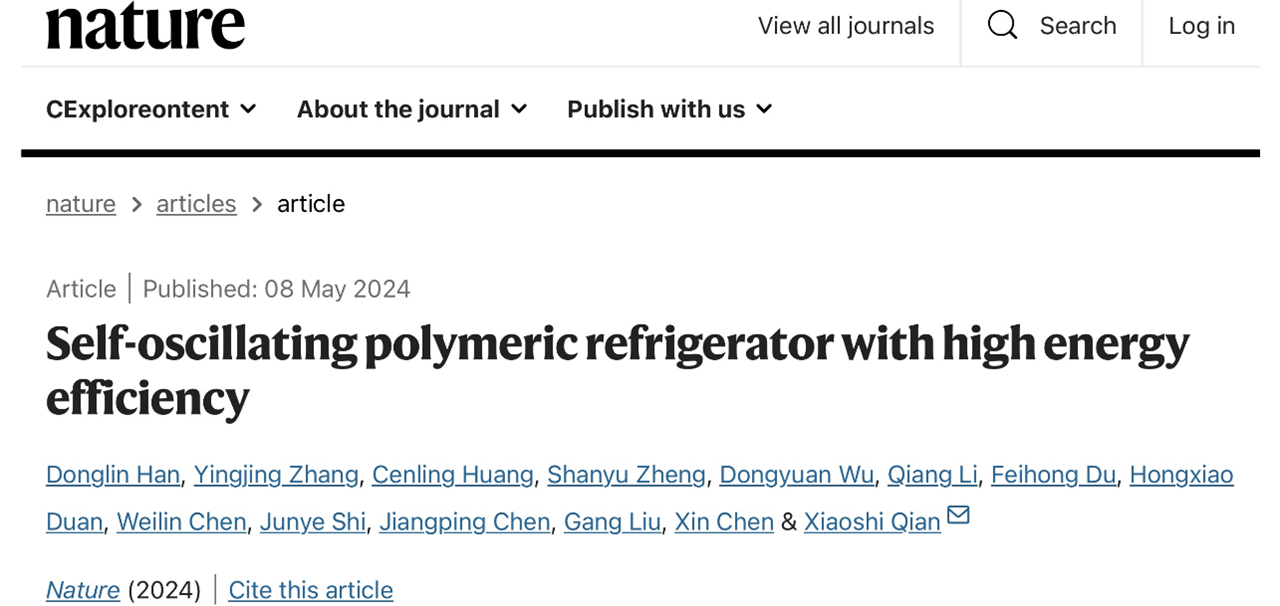
Han Donglin, a Ph.D. candidate from the class of 2024, has published two papers as the first author in the journal Nature. He has been awarded the National Scholarship for Master's and Doctoral Students, recognized as an Outstanding Graduate of Shanghai, and honored with the titles of "Academic Star", "Person of the Year", and "Triple-A Student" by Shanghai Jiao Tong University.
Zhang Yingjing, a Master's graduate from the class of 2024, has published one paper as a co-first author in the journal Nature. She has received the Gold Award in the East China Division of the second "Chuangqingchun" China Youth Carbon Neutrality Innovation and Entrepreneurship Competition, the Gold Award in the Shanghai Division of the "Internet Plus" (2023) competition, the National Scholarship, and has been honored as an Outstanding Student Party Member.
Qian Xiaoshi, a Distinguished Professor at Shanghai Jiao Tong University, is mainly engaged in the research of multi-field coupling in condensed phase-phase transitions and intelligent thermal systems. He proposed the "high entropy enhancement" method for ferroelectric materials, designed and synthesized high-entropy relaxor ferroelectric polymers, discovered the giant electrocaloric effect in ferroelectric polymers, and achieved over one million cycles of electrocaloric refrigeration components. He has also manufactured a series of prototype of electrocaloric cooling systems. Qian has presided over several basic research projects and topics, including national talent special projects, national youth talent projects, National Natural Science Foundation of China general projects, key research and development plan projects, and original exploration projects in the field of basic research funded by the Shanghai Science and Technology Commission. He has been recognized as a Shanghai Young Science and Technology Talent, a Siyuan Scholar at Shanghai Jiao Tong University, and has received honors and awards for the top ten scientific and technological advancements, among others.
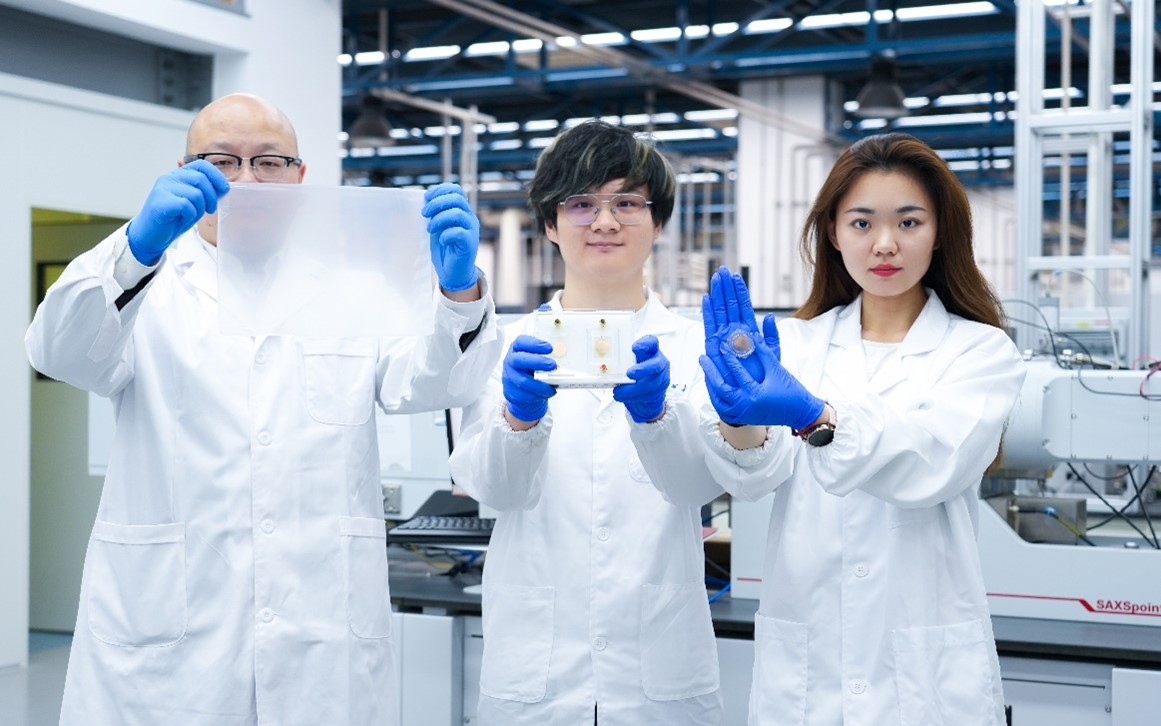
By combining the electrocaloric (EC) effect and electrostriction effect of relaxor ferroelectric polymer materials under the influence of an electric field, the research team has designed and manufactured a "self-oscillating" polymer thin-film cooling system. This system does not require an external driving device but instead optimizes the electromechanical coupling efficiency of the polymer refrigerant itself. By designing a method that synergistically drives the electro-mechanical deformation and electrocaloric cooling effect, the system achieves a lightweight, high energy efficiency ratio, high precision, and intelligent cooling effect.
The EC cooling technology that characterized by the giant EC effect, is hailed by the International Energy Agency as one of the disruptive and forward-looking technologies in the field of refrigeration due to its theoretical advantages of being fully solid-state, high energy efficiency, zero greenhouse warming potential, and ease of miniaturization and light weighting. In EC cooling systems, solid-state electrocaloric materials (refrigerants) achieve intermittent heat absorption and release effects under the application and removal of an electric field. By coordinating the spatial movement of the refrigerants, they alternately contact the heat source and heat sink, thereby completing the refrigeration cycle. Currently, the vast majority of reported EC cooling systems rely on external driving equipment (such as mechanical pumps, pistons, motors, etc.) to achieve the mechanical circulation movement of the refrigerant. These devices often require separate power sources and have a much larger volume and weight compared to the actual electrocaloric refrigerant in the system. Once deployed, how to reflect the advantages of electrocaloric cooling technology in miniaturization and light weighting has always been a significant challenge within the field.
Previously, Professor Qian Xiaoshi's research group confirmed in the Nature journal published in 2021 that by modifying the molecules within the polymer chains, it is possible to significantly enhance the entropy change performance of relaxor ferroelectric polymer materials under low electric fields. These materials are referred to as Double-bond Modified Polymers (DMP). In this paper, researchers further optimized the proportions of various monomers to ensure that the target polymer possesses both high "electro-induced entropy change" and high "electrostrictive strain" properties. Under an electric field of 66.7 MV/m, the DMP exhibited an adiabatic temperature change of 9 K and an in-plane strain of 1.9%. Thanks to the significantly enhanced mechano-electric-thermal coupling performance, the DMP film does not require additional mechanical driving force input. Under the influence of an electric field, it can simultaneously generate a sufficiently large spatial displacement and temperature change, forming a complete thermodynamic cycle solely through its intrinsic physical effects.
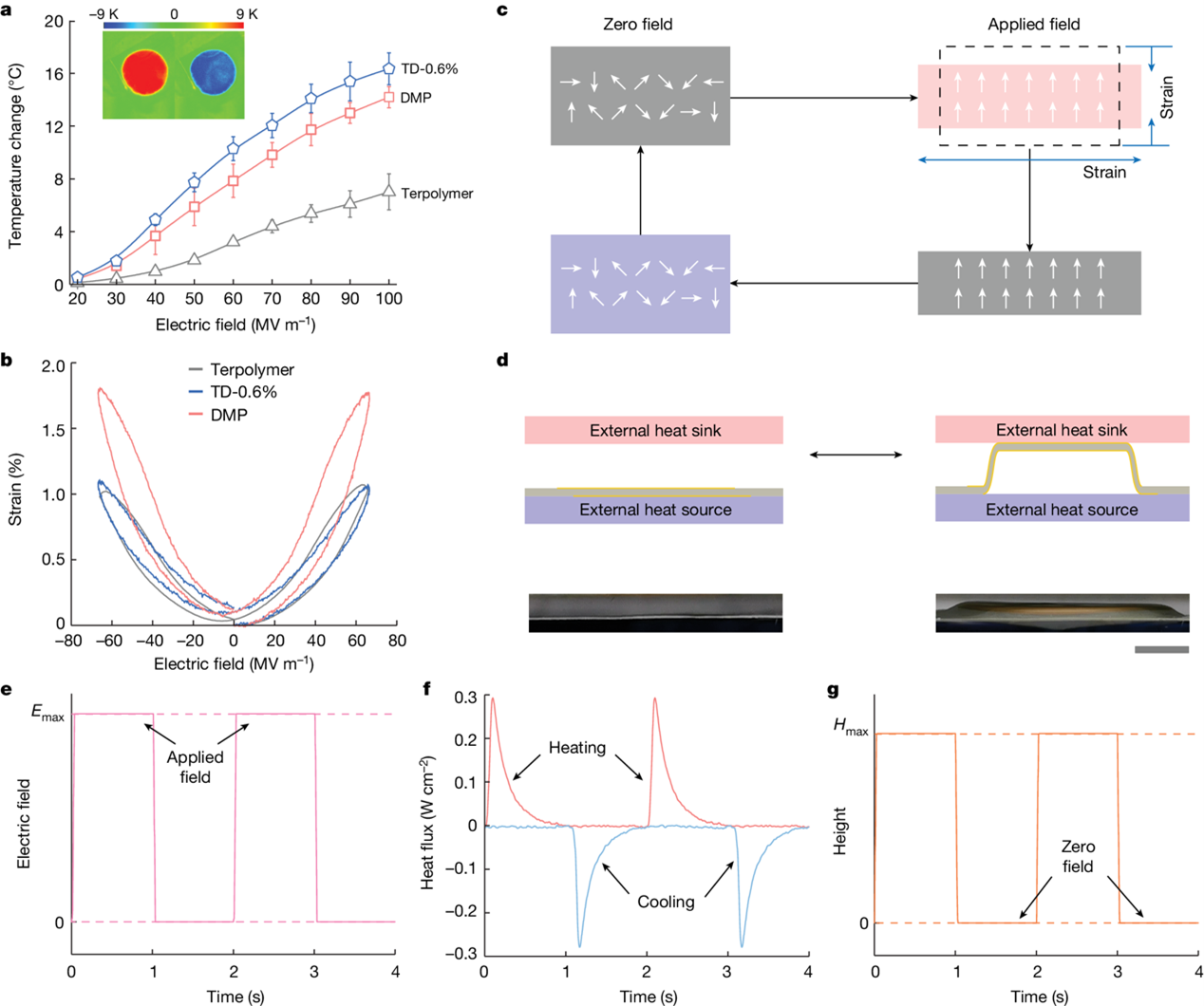
Fig. 1 Mechanism of self-cycling soft refrigerator
Based on the operational logic of the system, researchers built a temperature span test platform and tested the system's ability to create a temperature span under both heating and cooling conditions. Under an electric field of 66.7 MV/m and an operating frequency of 0.5 Hz, the system was able to achieve a temperature span of approximately 4 K in both conditions, indicating relatively low energy consumption. By employing interface thermal resistance measurement calibration experiments and finite element simulation calculations, the researchers conducted an in-depth analysis of the system's temperature span test results. The simulation results suggest that the interfacial contact thermal resistance and convective heat transfer losses during the system's operation are the primary factors that limit the system's cooling performance.
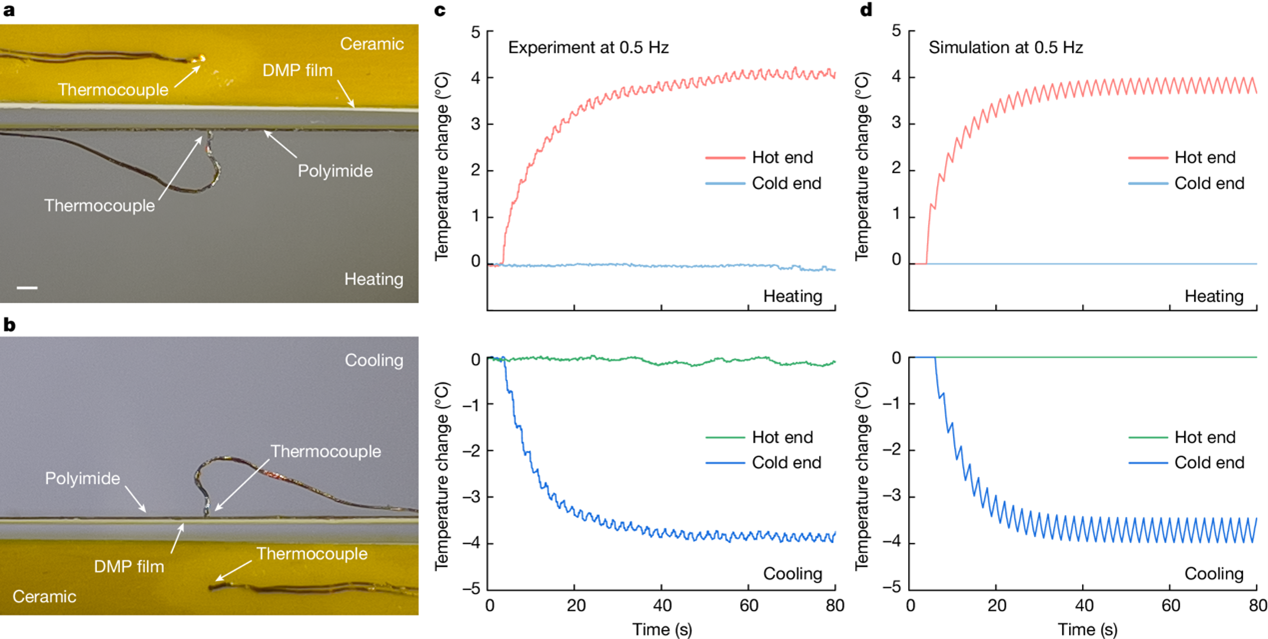
Fig. 2 Performances of the thin-film refrigerator in open ambient conditions.
How to accurately test the performance of an EC cooling system is another key focus in this field. Previously reported EC cooling systems mainly describe their performance through the system's temperature span, yet the standards for the temperature spans that different systems can achieve vary. In this work, for the first time, researchers introduced traditional refrigeration system testing techniques into the performance testing of EC cooling systems. They built an enthalpy difference bench suitable for thin-film EC cooling systems and independently and strictly controlled the temperatures of the heat source and heat sink. The researchers tested the cooling capacity that the EC cooling system can output under different heat source and heat sink temperature difference conditions, that is, under different working temperature spans, and obtained the additional external cooling capacity and coefficient of performance (COP) of the system under different temperature span conditions, rather than the cooling capacity and COP when the system is at the maximum temperature span and balanced with heat loss.
Under a zero-temperature span, the system can deliver a specific cooling power of 6.5 W/g, with a ratio of instantaneous cooling capacity to power consumption as high as 58 (under the condition of an 80% charge recovery efficiency). At a system temperature span of 4 K, the system can output a specific cooling power of 2.7 W/g, with a corresponding COP of 24, achieving approximately 32% of the thermodynamic perfection, which is the highest thermodynamic perfection reported to date in EC cooling system research. It is worth noting that the system's COP is closely related to the temperature span it is in and the energy recovery efficiency. If the charge recovery efficiency is increased to above 99.7%, the COP achieved by the system under a zero-temperature span would reach around 210. In addition, due to the absence of external driving components, the thin-film cooling system constructed in this study has a high space utilization rate, and its specific cooling power per unit volume is nearly a hundred times higher than that of the EC cooling systems reported in the field.
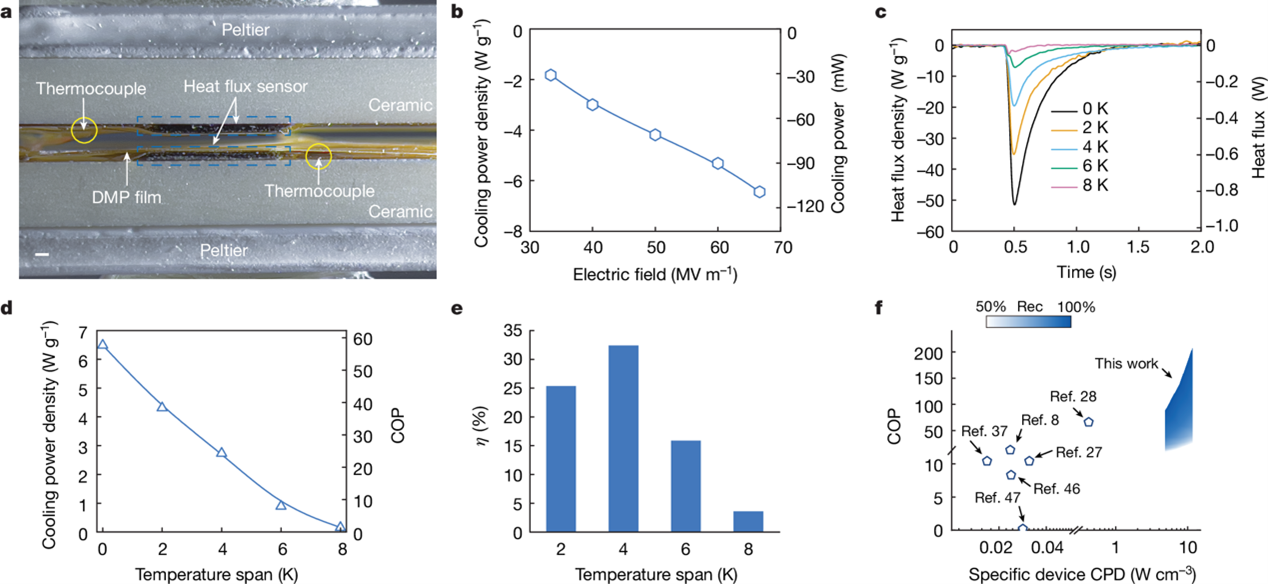
Fig. 3 CPD and COP of the thin-film refrigerator
The system can provide additional cooling capacity for chips in confined spaces, rapidly reducing the surface temperature of the chips. Compared to natural air convection cooling, the system can provide an additional temperature drop of 17.5 K for the chip within 50 seconds. Researchers have utilized the dielectric temperature spectrum of ferroelectric polymers to achieve real-time and targeted monitoring of the cooled object's temperature, and have designed a feedback operation logic for the automatic start and stop of the system's cooling work. The researchers also conducted over 70,000 cycles of stability testing on the system to verify its stability. Therefore, with its advantages of being lightweight, compact, and low-energy consumption, the self-driven EC cooling system, which synergizes the electrostrictive effect and the EC effect, can achieve flexible, high-energy efficiency, and intelligent active cooling.

Fig. 4 Application demonstration of the soft self-cycling refrigerator.
This article reveals the design mechanism of a self-driven EC cooling system based on ferroelectric polymers, innovates the rigorous testing methods for EC cooling systems, and provides a detailed and comprehensive characterization and analysis of the cooling capacity of EC cooling systems under various operating conditions. It verifies the theoretical advantages of lightweight and high energy efficiency of EC cooling technology, providing a theoretical foundation for future in-depth interdisciplinary basic research and engineering application exploration. Professor Qian Xiaoshi's team has been granted relevant invention patents. The research work was supported by Professor Chen Jiangping from the School of Mechanical Engineering and Professor Liu Gang from the School of Electronic, Information and Electrical Engineering, and all research work was completed by researchers from Shanghai Jiao Tong University. The research work was supported by the National Key R&D Program, the National Natural Science Foundation of China, the Shanghai Natural Science Foundation, the National Key Laboratory for Mechanical Systems and Vibration of Shanghai Jiao Tong University, the "Deep Blue" project of Shanghai Jiao Tong University, the Key Prospective Layout Fund, and the "Jiao Da 2030" project. The research work was also supported by the Shanghai Jiao Tong University Student Innovation Center, the Shanghai Jiao Tong University Analysis and Testing Center, and the National Major Scientific and Technological Infrastructure for Translational Medicine (Shanghai).

Shanghai Jiao Tong University
Address: 800 Dongchuan Road, Shanghai
200240